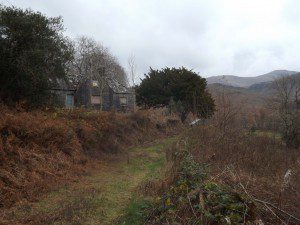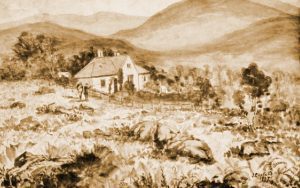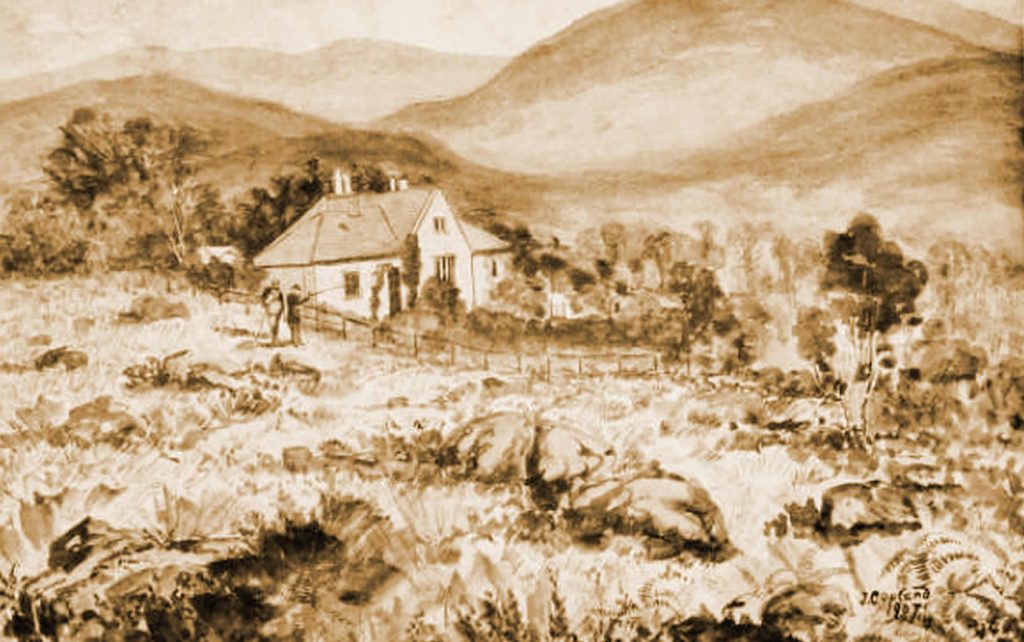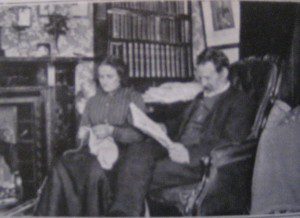Who lives in a house like this?
Glenhead of Trool and the cultural conservation of Galloway’s rural history.
by Cally Phillips
I’m currently writing the first in a series of books: ‘Discovering Crockett’s Galloway,’ which will be out in spring and as part of the process I’ve been spending the winter in the Galloway hills. Virtually. My sojourn has seen me spend an inordinate amount of time in two places from Crockett’s work; one of which may never have existed, and one of which may not exist for much longer. The first is the fictional ‘Shiel of the Dungeon of Buchan’ home to the Faa clan in the novel ‘The Dark o’ the Moon’ and the second, which is the subject of this piece, is Glenhead of Trool.
 [Glenhead of Trool – current photo]
[Glenhead of Trool – current photo]
Currently managed by the Forestry Commission, it’s been a bone of contention for some years. Recently visited with the threat of demolition, I believe it is now scheduled to go up for sale on the open market this month. I threw my hat in the ring late last year suggesting that to demolish it would be an act of cultural and historic vandalism, a belief I still hold. It may once more become a private home, but it’s a shame that something more creative can’t be done to conserve or restore it for everyone. It seems to me that there’s a parallel to be drawn between our treatment of Crockett and that of Glenhead, a parallel which reflects rather poorly upon our understanding and attitudes towards Galloway’s unique rural cultural history.
Glenhead, or Bongil as it was previously known, was tenanted over several centuries. The last tenant moved out as late as the 1990’s. For many generations the McMillan family farmed the land and during Crockett’s time John and Marion McMillan lived there. They first met in August 1893 when Crockett was undertaking research for ‘The Raiders.’ John McMillan was knowledgeable about the Galloway Hills and became an invaluable guide, then a lifelong friend.
 [Glenhead of Trool – J.Copland]
[Glenhead of Trool – J.Copland]
This is Crockett’s first recorded impression of Glenhead:
Glenhead I saw for the first time in the broad glare of a mid-noon sun. All the valley swam in a hazy blue mist, and the heat smote down from the white lift as through the glass of a hothouse.
Yet I have been in Glenhead during those winter days when for six weeks the sun does not touch its highest chimney-top, so deep the little granite house sits under the giant hills about it—Bennanbrack, Curlywee, Lamachan, and its own Gairy shouldering up close behind it.
Differing from all the other farms, at Glenhead everything is ‘black-faced sheep.’ Their ways, their care, their difficulties from season to season, their strange simplicity, their yet stranger outbreaks of unexpected wisdom—the latter chiefly among the ladies of the flock, those mothers in Israel, ‘naw-breakers’ by name, who charge some stubborn snow-wreath, and so lead out their juniors to safety, and new if scanty pastures.
Especially in ‘lambing-time’ all here gives way to ‘the yowes.’ The ailments of a mere human are nothing to those of a ewe ‘fa’en aval.’ The mistress herself establishes hospitals and orphanages, and becomes at once house-surgeon, hospital dresser, and an entire staff of nurses.
Beneath the house are winding ribbons of meadow grass following the meanderings of a stream. Enclosed by a wall behind you will find a ‘park’ or two. A tennis-lawn of corn waves green in the hollow, a forenoon’s work to cut for an able-bodied man. Beneath remote Clashdaan, away on the shores of Loch Dee, you will find another triangle of meadow grass, the produce carefully ricked and carried up beyond floodmark. Then behind these the farm rolls back mile after mile. The number of its acres none knows to a hundred or so, all hills of sheep—nothing but black-faced sheep, unless you may count a random fox marauding from Bennanbrack, or a rabbit cocking his white fud over a brae.
Heather and rock, loch and lochan, islet and bare granite peak! So it goes on mile after mile, growing ever more and more lonely and remote, till above Utmost Enoch you look out upon a land like that where never man comes
‘Nor hath come, since the making of the world.’
This is the true Raiders’ Country.
Glenhead served as a base for Crockett on several trips into the hills with John McMillan, researching both ‘The Raiders,’ and ‘The Men of the Moss Hags.’ He describes the pleasure of coming home to Glenhead at the end of the day.
It is dusking into dark as we master the final slope, and to the barking of dogs, and the cheerful voices of kindly folk, we overpass the last hill dyke, and enter the sheltering homestead of Glenhead, which looks so charmingly out over its little crofts down to the precipice-circled depths of Loch Trool.
In ‘Men of the Moss Hags’ he describes an earlier Glenhead, from ‘The ‘Killing Times.’
When we went into the little house of Bongill, we found an open door both back and front. Peats were blazing on the hearth. Great dishes of porridge sat on a table. Chairs and stools were overturned, and Bibles and Testaments lay everywhere.
‘Curse the old dog. He has sung them a’ to the hill,’ cried Douglas. ‘Have him out and shoot him.’
Even in those times Glenhead was a place of safety, of refuge from the murderous intent of The King’s Men, who hunted down the Covenanters all over the Galloway hills. In his own day Crockett introduces us to Glenhead full of life and love, as it was over a century ago.
‘Heartsome content within, placid stillness without as we ride up—a broad straw hat lying in a friendly way upon the path—the clamour of children’s voices somewhere down by the meadow—a couple of dogs that welcome us with a chorus of belated barking—this is Glenhead, a pleasant place for the wandering vagabond to set his foot upon and rest awhile. Then after a time, out of the coolness of the narrow latticed sitting-room (where there is such a collection of good books as makes us think of the nights of winter when the storms rage about the hill-cinctured farm), we step, lightly following, with many expectations, the slow, calm, steady shepherd’s stride of our friend—the master of all these fastnesses—as he paces upwards to guide us over his beloved hills.’
Whatever your attitude to fiction, I believe an important aspect of the writing of S.R.Crockett is his ability to preserve the past. He gives us a glimpse into real lives, real people and real places, which while often fictionalised, bear the hallmark of truth. His ability to create a sense of place and to describe the minutiae of the lives of the ordinary rural Gallovidian are unparalleled and well worth conserving for posterity.
In ‘Rose of the Wilderness’ set in 19th century, Glenhead is once again mentioned:
‘I had cow’s milk fetched from the Macmillans’ house at Bongill – a good ten miles. But father fell lame, and could not do the daily double journey, though he held out a long while.
My current research suggests that the Gordon home in ‘Rose of the Wilderness’ is based on (if not actually) ‘The Back Hill o’ the Bush,’ which is also Forestry Commission managed and under threat from vandalism and mis-use. Which serves to remind us that Glenhead is not the only place in the Galloway Hills in need of conservation or restoration. Caldons and Tunskeen are also mentioned in Crockett’s writing, and I’ll write about ‘The Back Hill o’ the Bush’ next month. In the meantime I’m more than happy to chat with anyone interested in Glenhead, and/or Bothies and rural Galloway dwellings in general. And if anyone has a lead on ‘The Shiel of the Dungeon of Buchan’… well, that’d just make my day.
You can contact me via [email protected]. And to find out more about S.R. Crockett and his work, why not visit The Galloway Raiders website and join for free. www.gallowayraiders.co.uk







